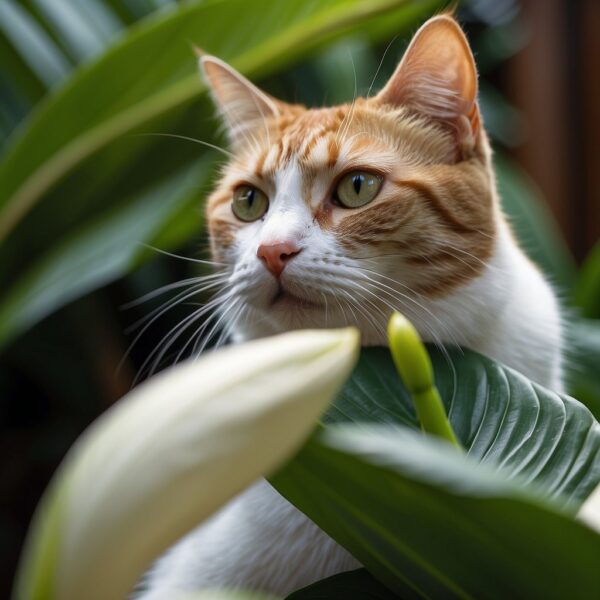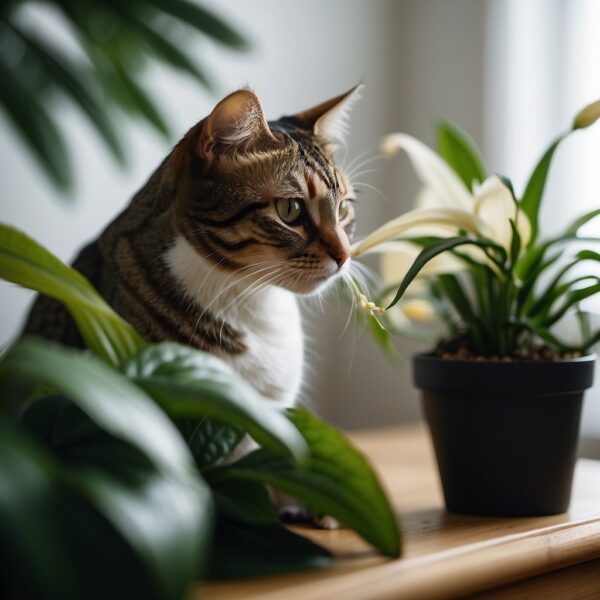
Peace Lilies are Toxic To Cats: Risks to Cat Health
Cat parents often question the safety of houseplants, particularly when it comes to the beautiful and popular peace lily. The peace lily, while not a true lily, possesses attributes that can be toxic to cats. These plants contain calcium oxalate crystals, which if ingested, can lead to a variety of symptoms in felines ranging from mild to moderate in severity.
Because of the intrinsic curiosity of cats, they might chew on the leaves or flowers of a peace lily, which can result in oral irritation and gastrointestinal discomfort. Immediate action and awareness are crucial for cat parents to protect their pets from the potential risks of peace lily toxicity, as symptoms like intense burning and irritation of the mouth, excessive drooling, vomiting, and difficulty swallowing can occur.
Key Takeaways
- Peace lilies contain substances that can cause oral and stomach discomfort in cats.
- Ingestion of peace lilies by cats warrants prompt intervention to mitigate health risks.
- Cat parents should practice caution by preventing cats’ access to peace lilies and be informed on how to address potential poisoning.
Toxicity of Peace Lilies to Cats
Peace lilies contain toxic compounds that are harmful to cats. It is crucial for cat parents to recognize the symptoms of toxicity and understand what makes the plant dangerous.
Active Toxic Agents
Peace lilies (Spathiphyllum spp.) possess calcium oxalate crystals, which are insoluble and act as an irritant. These crystals are found in all parts of the plant and can cause harm when ingested by cats.
Symptoms of Toxicity in Cats
When a cat ingests peace lilies, the animal may exhibit signs of toxicity due to the irritant nature of calcium oxalate crystals. Key symptoms include:
- Oral irritation: swelling of the lips, tongue, and mouth.
- Gastrointestinal upset: difficulty swallowing, drooling, vomiting.
- Respiratory distress: in severe cases, can lead to difficulty breathing.
Immediate veterinary care is advised if a cat exhibits any of these symptoms after contact with peace lilies.

Peace Lily Toxicity: Immediate Actions for Cat Parents
When a cat ingests peace lilies, time is of the essence. Immediate action centered on first-aid measures can mitigate the plant’s irritating effects, while contacting a veterinarian is critical for proper assessment and treatment.
First-Aid Measures
If they witness or suspect their cat has chewed on or ingested peace lily plant material, guardians should:
- Remove any plant remnants: Gently remove any pieces of the plant from the cat’s mouth to prevent further ingestion.
- Rinse the mouth: Use clean water to rinse the cat’s mouth gently to help alleviate oral irritation caused by the calcium oxalate crystals found in peace lilies.
Veterinary Care Procedures
Following first-aid measures, cat parents need to:
- Consult a veterinarian: Contact a veterinarian or a pet poison helpline immediately, even if symptoms are not yet apparent.
- Follow professional advice: The veterinarian may recommend bringing the cat in for a thorough examination and treatment, which could include fluids, medication to control symptoms, or more specific interventions depending on the severity of the ingestion and symptoms.

Preventive Measures for Cats and Peace Lilies
When it comes to peace lilies and cats, the primary objective is to ensure the safety of the pets by preventing exposure. This involves exploring non-toxic plant alternatives and taking steps to cat-proof the home environment.
Safe Alternatives for Cats
Cats are natural explorers and may be attracted to houseplants. Cat parents looking to maintain a green space without harming their feline friends should consider these non-toxic plants:
- Boston Fern (Nephrolepis exaltata): A lush, humidity-loving plant safe for cats.
- Spider Plant (Chlorophytum comosum): Recognized for its air-purifying qualities and non-toxicity.
- Areca Palm (Dypsis lutescens): Offers a tropical feel and is safe for both cats and dogs.
Tips for Cat-Proofing Your Home
To prevent cats from coming into contact with toxic plants like peace lilies, follow these cat-proofing tips:
- Secure Plant Placement: Keep peace lilies and other toxic plants out of reach, ideally in locked or inaccessible rooms.
- Consistent Training: Discourage cats from chewing on plants with firm “no” commands and redirection to appropriate activities.
- Plant Substitutes: Offer safe alternatives like cat grass to satisfy a cat’s urge to graze.

Understanding Peace Lilies
Peace Lilies, scientifically known as Spathiphyllum, are popular houseplants admired for their lush foliage and elegant white blooms. Recognized for both their beauty and air-purifying qualities, these plants have specific characteristics and common indoor locations.
Botanical Profile
Spathiphyllum, commonly called Peace Lilies, belong to the family Araceae. They are not true lilies but share a similar appearance with their graceful, white spathes that resemble flowers cradling the spadix. Typically, Peace Lilies can grow between 1 to 4 feet tall and possess broad, dark green leaves that arch elegantly. Here’s a brief overview of their botanical attributes:
- Scientific Name: Spathiphyllum
- Family: Araceae
- Common Names: Peace Lily, White Sails, Mauna Loa (specific cultivar)
- Growth Habit: Clump-forming perennial
- Height: 1 to 4 feet
- Leaf Shape: Elongated with a pointed tip
- Flower: White spathe surrounding a spadix
Common Household Placement
Peace Lilies are typically placed in indoor environments where they can receive filtered light and are away from direct sunlight. They thrive in temperatures between 65-80°F (18-27°C) and prefer high humidity environments. Given their aesthetic appeal, they are commonly found in living rooms, bedrooms, and office spaces, often occupying spots such as:
- Corner spaces with indirect lighting
- On office desks or shelves
- Window sills with diffused sunlight
It is important for plant owners to consider pet accessibility when choosing the plant’s location, especially if they live with cats, due to the mild toxicity of Peace Lilies when ingested.
Frequently Asked Questions
When dealing with peace lilies and cats, it’s crucial to understand the risks and appropriate actions to take for their safety. Knowing the symptoms of toxicity, preventive measures, and safe alternatives can help cat owners create a healthy environment for their pets.
What symptoms should I watch for if my cat has ingested a peace lily?
If a cat ingests part of a peace lily, the parent may notice symptoms such as drooling, vomiting, pawing at the mouth, and a reduced appetite. The cat may also experience difficulty swallowing due to irritation and swelling in the mouth.
How can I keep my cat safe around peace lilies?
To keep cats safe, peace lilies should be placed out of reach or removed from homes with cats. Consider using cat-friendly deterrents or choose non-toxic plants as safer alternatives.
What should I do immediately if my cat eats part of a peace lily?
If a cat eats any portion of a peace lily, it should be taken to the veterinarian immediately. Quick and professional assessment and treatment are essential for mitigating the effects of the toxin.
Which houseplants are safe to keep around cats?
Houseplants such as spider plants, Boston ferns, and areca palms are safe for cats. Parents can also consider adding cat grass to their homes, which is both safe and beneficial for felines.
Can peace lily exposure affect dogs in the same way as cats?
Yes, peace lilies can also affect dogs similarly, causing symptoms like oral irritation, drooling, vomiting, and appetite loss.
Are there any lilies that are safe for cats?
No true lilies (Lilium and Hemerocallis species) are safe for cats. All parts of these plants are highly toxic and potentially lethal. Cat parents should avoid any plant labeled as a true lily.